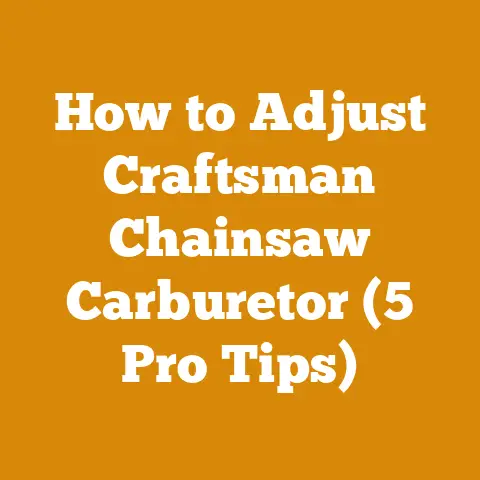How to Prune Dogwood Bush (Seasonal Tips for Safe Limb Removal)
Understanding Dogwood Bushes and Their Pruning Needs
Dogwoods (Cornus spp.) are known for their stunning spring blooms, vibrant fall foliage, and attractive bark. Whether you have a flowering dogwood tree (Cornus florida) or a shrub dogwood like the red-osier dogwood (Cornus sericea), understanding their growth habits is crucial for proper pruning.
Growth Habits and Pruning Goals
Dogwood bushes typically grow as multi-stemmed shrubs, often spreading through suckers. Pruning aims to:
The best time to prune depends on the specific species and your pruning goals.
- Late Winter/Early Spring (Dormant Season): This is the ideal time for major pruning, as the plant is dormant and less susceptible to stress. You can easily see the plant’s structure and make informed decisions about which branches to remove.
- Late Spring/Early Summer (After Flowering): For flowering dogwoods, prune immediately after the blooms fade. This allows you to remove spent flowers and shape the plant without sacrificing the following year’s flower production.
- Late Summer/Early Fall: Avoid pruning during this period, as it can stimulate new growth that may not harden off before winter, making it vulnerable to frost damage.
Essential Tools for Pruning Dogwood Bushes
Having the right tools is essential for safe and effective pruning. Here’s a list of tools I recommend, along with tips for their maintenance:
- Hand Pruners: Ideal for cutting small branches (up to 1/2 inch in diameter). I prefer bypass pruners, as they make cleaner cuts than anvil pruners.
- Loppers: Used for cutting larger branches (up to 2 inches in diameter). Loppers provide more leverage than hand pruners, making it easier to cut thicker stems.
- Pruning Saw: Essential for removing branches larger than 2 inches in diameter. A folding pruning saw is compact and easy to carry.
- Pole Pruner: Useful for reaching high branches without using a ladder. Choose a pole pruner with a telescoping handle for added versatility.
- Gloves: Protect your hands from thorns and scratches.
- Eye Protection: Safety glasses or goggles are essential to protect your eyes from flying debris.
- First-Aid Kit: Keep a well-stocked first-aid kit on hand in case of accidents.
Tool Maintenance for Optimal Performance
- Clean Your Tools: After each use, clean your pruning tools with a disinfectant solution (e.g., a mixture of bleach and water) to prevent the spread of diseases.
- Sharpen Your Blades: Sharp blades make cleaner cuts and reduce the risk of damaging the plant. Use a sharpening stone or file to keep your blades sharp.
- Lubricate Moving Parts: Apply a few drops of oil to the moving parts of your pruners and loppers to keep them working smoothly.
- Store Your Tools Properly: Store your pruning tools in a dry place to prevent rust and corrosion.
Step-by-Step Guide to Pruning Dogwood Bushes
Now that you have the right tools and understand the seasonal considerations, let’s dive into the actual pruning process.
1. Assess the Plant
Before you start cutting, take a step back and carefully assess the plant. Look for:
- Dead, Diseased, or Damaged Branches: These should be removed first.
- Crossing or Rubbing Branches: These can create wounds that are susceptible to infection.
- Weak or Spindly Growth: Remove these to encourage stronger, more vigorous stems.
- Suckers: These are new shoots that emerge from the base of the plant. Remove them to prevent the bush from spreading too aggressively.
2. Remove Dead, Diseased, or Damaged Branches
Use your hand pruners, loppers, or pruning saw to remove any dead, diseased, or damaged branches. Cut back to healthy wood, making sure to leave a clean, smooth cut.
- Disease Management: If you suspect a branch is diseased, disinfect your pruning tools after each cut to prevent the spread of the disease.
- Proper Cutting Technique: When removing a branch, make the cut just outside the branch collar (the swollen area where the branch joins the trunk or another branch). Avoid cutting flush with the trunk, as this can damage the tree’s vascular system.
3. Thin Out the Bush
Thinning involves removing selected branches to improve air circulation and reduce crowding. Focus on removing:
- Crossing or Rubbing Branches: These can create wounds that are susceptible to infection.
- Branches Growing Inward: These can block sunlight and reduce air circulation.
- Weak or Spindly Growth: These are unlikely to produce flowers or attractive bark.
- Old, Unproductive Stems: These can be identified by their thick, gnarled appearance.
4. Head Back Remaining Branches (Optional)
Heading back involves shortening the length of remaining branches. This can be done to:
- Control the Size and Shape of the Bush: Head back branches to maintain the desired size and shape.
Encourage Bushier Growth: Heading back stimulates the growth of lateral buds, resulting in a denser, more compact plant.
Proper Heading Cuts: When heading back a branch, make the cut just above a healthy bud that is facing in the direction you want the new growth to go.
5. Remove Suckers
Suckers are new shoots that emerge from the base of the plant. Remove them to prevent the bush from spreading too aggressively and to maintain a tidy appearance.
- Effective Sucker Removal: Cut suckers off at ground level, or even slightly below, to prevent them from regrowing.
6. Clean Up Debris
Once you’ve finished pruning, clean up all the debris (branches, leaves, etc.) and dispose of it properly. This will help prevent the spread of diseases and pests.
- Composting: Healthy prunings can be composted. Diseased prunings should be burned or disposed of in the trash.
- Chipping: Larger branches can be chipped and used as mulch.
Pruning Techniques for Specific Dogwood Species
While the general pruning principles apply to all dogwood bushes, there are some specific considerations for different species.
Flowering Dogwood (Cornus florida)
- Pruning Timing: Prune immediately after flowering in late spring or early summer.
- Pruning Goals: Focus on removing dead, diseased, or damaged branches, thinning out crowded areas, and shaping the plant. Avoid heavy pruning, as this can reduce flowering.
Red-Osier Dogwood (Cornus sericea)
- Pruning Timing: Prune in late winter or early spring.
- Pruning Goals: Red-osier dogwoods are prized for their brightly colored bark, which is most vibrant on new growth. To encourage new growth, prune up to one-third of the oldest stems down to the ground each year. This will stimulate the production of new, colorful stems.
Kousa Dogwood (Cornus kousa)
- Pruning Timing: Prune in late winter or early spring.
- Pruning Goals: Kousa dogwoods tend to have a more tree-like form than other dogwood species. Focus on removing dead, diseased, or damaged branches, thinning out crowded areas, and shaping the plant to maintain a balanced form.
Common Pruning Mistakes to Avoid
Pruning can seem daunting, but avoiding these common mistakes will help you achieve the best results:
- Pruning at the Wrong Time: Pruning at the wrong time of year can stress the plant and reduce flowering. Always prune according to the recommended timing for your specific dogwood species.
- Over-Pruning: Removing too much of the plant can weaken it and make it more susceptible to diseases and pests. Start with light pruning and gradually remove more branches as needed.
- Leaving Stubs: Leaving stubs when removing branches can create entry points for diseases and pests. Always cut back to the branch collar or a healthy bud.
- Using Dull Tools: Dull tools can tear the bark and damage the plant. Always use sharp, well-maintained tools.
- Ignoring Safety Precautions: Always wear gloves and eye protection when pruning. Be careful when using ladders or pole pruners, and never work in wet or windy conditions.
The Science Behind Pruning: How Plants Respond
Understanding the science behind pruning can help you make more informed decisions and achieve better results.
Apical Dominance
Apical dominance is the phenomenon where the terminal bud (the bud at the tip of a branch) inhibits the growth of lateral buds (buds along the sides of the branch). When you prune off the terminal bud, you remove this inhibition, allowing the lateral buds to grow and produce new branches.
Wound Healing
When you prune a branch, you create a wound on the plant. The plant responds by forming a callus, a protective layer of tissue that seals the wound and prevents infection. Proper pruning techniques, such as cutting back to the branch collar, promote faster and more effective wound healing.
Plant Hormones
Plant hormones, such as auxins and cytokinins, play a crucial role in regulating plant growth and development. Pruning can alter the balance of these hormones, influencing the plant’s growth patterns. For example, removing the terminal bud can increase the concentration of cytokinins in the lateral buds, stimulating their growth.
Dogwood Health and Disease Prevention
Proper pruning is an essential part of maintaining the health and vigor of your dogwood bushes. By improving air circulation and removing diseased or damaged branches, you can reduce the risk of fungal diseases and pest infestations.
Common Dogwood Diseases
- Dogwood Anthracnose: A fungal disease that causes leaf spots, twig dieback, and cankers.
- Powdery Mildew: A fungal disease that causes a white, powdery coating on the leaves.
- Septoria Leaf Spot: A fungal disease that causes small, circular spots on the leaves.
Preventing Diseases
- Choose Disease-Resistant Varieties: When planting dogwoods, choose varieties that are known to be resistant to common diseases.
- Provide Proper Care: Ensure your dogwoods receive adequate sunlight, water, and nutrients.
- Maintain Good Air Circulation: Prune to improve air circulation within the plant.
- Remove Diseased Branches Promptly: Remove any diseased branches as soon as you notice them.
- Apply Fungicides (If Necessary): In severe cases, you may need to apply fungicides to control fungal diseases.
Managing Pests
- Dogwood Borer: A type of moth larva that tunnels into the wood of dogwood trees.
- Scale Insects: Small, immobile insects that suck sap from the leaves and stems.
- Aphids: Small, soft-bodied insects that feed on plant sap.
Preventing Pests
- Inspect Plants Regularly: Check your dogwoods regularly for signs of pests.
- Remove Infested Branches: Remove any infested branches as soon as you notice them.
- Encourage Natural Predators: Attract beneficial insects, such as ladybugs and lacewings, to your garden to help control pest populations.
- Apply Insecticides (If Necessary): In severe cases, you may need to apply insecticides to control pest infestations.
Case Studies: Pruning Dogwoods in Different Scenarios
To illustrate the principles of dogwood pruning, let’s look at a few case studies:
Case Study 1: Rejuvenating an Overgrown Red-Osier Dogwood
Scenario: A red-osier dogwood bush has become overgrown and leggy, with few brightly colored stems.
Pruning Approach:
- Assess the Plant: Identify the oldest, thickest stems.
- Remove Old Stems: Cut up to one-third of the oldest stems down to the ground.
- Thin Out Remaining Stems: Remove any crossing or rubbing branches.
- Fertilize: Apply a balanced fertilizer to encourage new growth.
Result: The pruning stimulates the production of new, brightly colored stems, rejuvenating the bush and improving its aesthetic appeal.
Case Study 2: Maintaining a Flowering Dogwood Tree
Scenario: A flowering dogwood tree has developed some dead and diseased branches.
Pruning Approach:
- Assess the Plant: Identify the dead and diseased branches.
- Remove Dead and Diseased Branches: Cut back to healthy wood, making sure to disinfect pruning tools after each cut.
- Thin Out Crowded Areas: Remove any crossing or rubbing branches.
- Shape the Tree: Prune to maintain a balanced, natural form.
Result: The pruning removes the diseased wood, improves air circulation, and helps maintain the tree’s health and beauty.
Case Study 3: Controlling the Spread of a Dogwood Bush
Scenario: A dogwood bush is spreading aggressively through suckers.
Pruning Approach:
- Remove Suckers: Cut suckers off at ground level, or even slightly below.
- Install a Root Barrier: To prevent future suckering, install a root barrier around the base of the plant.
Result: The pruning and root barrier effectively control the spread of the bush, preventing it from becoming invasive.
The Environmental Benefits of Pruning
Pruning not only benefits the health and appearance of your dogwood bushes but also has positive environmental impacts.
Reducing Waste
By pruning dead, diseased, or damaged branches, you can prevent them from becoming a source of disease or pest infestation. This reduces the need for chemical treatments, which can harm the environment.
Promoting Biodiversity
Healthy, well-maintained dogwood bushes provide habitat and food for a variety of wildlife, including birds, insects, and small mammals.
Improving Air Quality
Trees and shrubs play a vital role in absorbing carbon dioxide and releasing oxygen, helping to improve air quality. Pruning can enhance this process by promoting healthy growth and increasing the plant’s ability to photosynthesize.
Troubleshooting Common Pruning Problems
Even with careful planning and execution, you may encounter some challenges when pruning dogwood bushes. Here are some common problems and how to address them:
- Excessive Suckering: If your dogwood bush is producing a lot of suckers, it may be stressed or damaged. Ensure the plant is receiving adequate water and nutrients, and consider installing a root barrier to prevent suckering.
- Poor Flowering: If your flowering dogwood is not producing many flowers, it may be due to over-pruning, improper pruning timing, or insufficient sunlight. Avoid heavy pruning, prune immediately after flowering, and ensure the plant is receiving at least six hours of sunlight per day.
- Disease Problems: If your dogwood bush is showing signs of disease, such as leaf spots or twig dieback, remove the affected branches promptly and apply appropriate fungicides.
- Pest Infestations: If your dogwood bush is infested with pests, such as aphids or scale insects, remove the infested branches and apply appropriate insecticides.
Advanced Pruning Techniques for Dogwood Bushes
Once you’ve mastered the basics of dogwood pruning, you can explore some more advanced techniques to enhance the plant’s health and appearance.
Espalier
Espalier is the art of training trees or shrubs to grow flat against a wall or fence. This technique can be used to create a stunning focal point in your garden.
Topiary
Topiary is the art of shaping plants into ornamental forms. This technique can be used to create unique and eye-catching designs.
Grafting
Grafting is the process of joining two plants together so that they grow as one. This technique can be used to propagate desirable traits or to create interesting combinations of plants.
Conclusion: Nurturing the Beauty and Health of Your Dogwood
Pruning dogwood bushes is a rewarding task that can enhance their beauty, health, and longevity. By understanding the plant’s growth habits, following proper pruning techniques, and avoiding common mistakes, you can keep your dogwoods thriving for years to come. Remember to prune at the right time of year, use sharp tools, and always prioritize safety. With a little practice and patience, you’ll become a pruning pro in no time!






